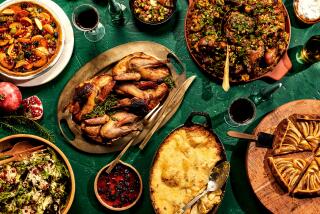DECORATION : Brighten Holidays With Colorful Garden : Fruits, flowers and berries, for instance, can add a lot, both outside and inside your home.
- Share via
Thanksgiving is a time for colorful fruits, flowers and berries, highlighted by orange and red shades that blend with the traditional pumpkins, gourds and Indian corn of autumn.
Many of these items are easily grown in the home garden. One is American bittersweet, a native vine that has long been a popular Thanksgiving decoration. It makes a fine fence covering and can form a dense screen. Male and female plants are needed--as with the delightful holly--to produce berries.
Many young bittersweet plants are seedling-grown, and there is no way for the homeowner to tell male from female plants until they are large enough to flower. The plant produces an orange capsule that splits open to reveal a scarlet fruit.
Washington hawthorn is another plant grown for color. It has clusters of orange-red berries on medium-size trees; it also has large thorns, so the plants should not be placed close to where children play or adults walk.
Another small, colorful tree is the flowering crab apple, with red and orange fruit that hangs on well into winter until severe cold turns them black or birds feast on them.
Deciduous holly, a small tree that produces typical red holly berries but drops its leaves in the fall, also provides winter accent in milder areas. Birds also enjoy these berries, which are suitable for holiday decoration alone or mixed with evergreens. Pyracantha, or firethorn, is another decorative item, but it suffers from severe cold in some areas.
A good viburnum for fall color is the American cranberry bush. It is cold-hardy and has clusters of edible, glossy red fruits that last well into winter, unless birds eat them. The Wright viburnum also is an abundant berry producer.
Growing low is the herbaceous perennial Chinese lantern (Physalis), which has fruit surrounded by a papery, inflated orange-colored husk. It is easily grown from seeds in spring, but normally does not produce abundant fruit until the second year.
Some old-fashioned or shrub roses provide color with orange or orange-red fruits called “hips.”
Chrysanthemums generally reach their garden peak in October, but they are durable enough to be useful Thanksgiving decorations.
Mums have few insect enemies, but there are a few common diseases, including leaf spots, especially in wet weather or where watering keeps foliage wet. In the first stages, small, dark-brown spots develop, gradually increasing in size until they unite to form an irregular pattern. The spots normally are more severe on the lower leaves and gradually move upward.
In septoria leaf spot, the affected leaves drop prematurely. In other leaf spots, the appearance may be quite similar, but dead leaves cling to the stem.
Spraying with a fungicide several times during the growing season can help control some leaf spots. Also, destroy diseased foliage as soon as noticed and avoid splashing water on the plants.
Another destructive disease of chrysanthemums is verticillium wilt, which may be carried on cuttings; plants may also be attacked by the fungus in the soil. Leaves first become pale green, then turn brown and die, but remain attached to the stem. Plants often wilt, then die.
Wilting sometimes occurs during the day, with recovery at night. Infected plants are normally stunted and flowers are small.
Remove and destroy infected plants, and don’t replant in the same area for at least a few years. Destroy aphids with an insecticide.






